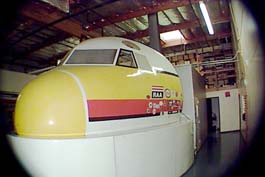
Here is a nice view of the last remaining Lockheed Electra
flight simulator in the world.
At one time this may have been on a motion base, but
as you can see, it's now on a fixed base.
This simulator is an IFR flight and Cockpit Procedures
Trainer.
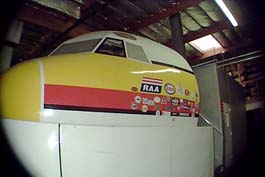
Here is another view of the exterior. The silver
box behind the cab is where the navigation instructor's console is located.
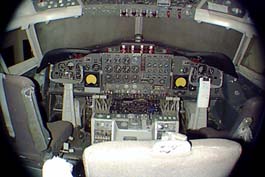
This is the interior of the Electra. The third
seat at the bottom of the picture is for the Flight Engineer.
Notice that instead of having a central throttle quadrant,
both the Captain and First Officer have their own set of throttles. The
throttles are designed to reverse the prop pitch when lifted and pulled
completely aft. This has the same effect as a thrust reverser on
a standard jet airliner.
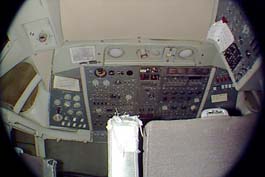
This view shows one of the Flight Engineer panels on
the upper right and the upper portion of the central overhead panel.
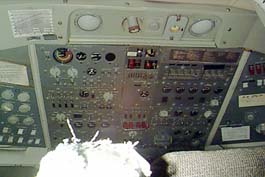
Here is a bit of a better view of the central overhead.
Unfortunately it's been far too long since I worked on this beast to be
able to accurately describe anything you see here. :)
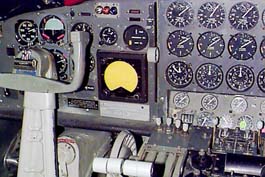
This is the Captain's side of the flight deck.
The yellow display is a Bendix weather radar display.
The gauges visible, from top to bottom are:
1. RPM 2.
Turbine Inlet Temperature
I don't recall what the third is and the image is not
clear enough for me to puzzle it out based upon the scale. If anyone can
tell me what it is, I'd be happy to list it. The four throttles are
visible in the lower middle of the picture.
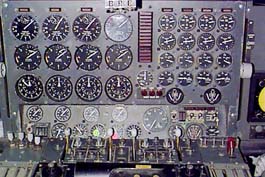
This is a much better picture of the engine gauges.
Electra pilots were VERY busy people. The center stack of red indicators
are various system warning and failure lights. The gray knob to the
far right is the landing gear handle.
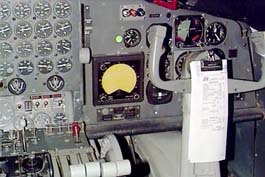
This is the First Officer's office. As you can
see, it's a duplicate of what is on the Captain's side. You can see
the ADI or Artificial Horizion and the Altimeter. The silver, orange and
blue lamp assembly is the Inner, Middle and Outer marker lights.
As the aircraft approaches these navigation beacons, the light will blink
with the morse code that's being transmitted from each beacon. What
PC flight simulators never seem to simulate is the sound of approaching
and leaving the "cone" these beacons transmit. As the aircraft approaches
each beacon, the sound & illumination is very faint, increasing with
volume and brightness as the aircraft flies over the area of highest signal
strength, and then diminishing again as the plane flies away from the respective
beacon.
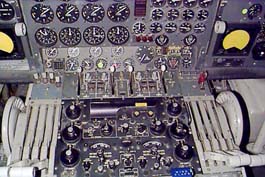
In this image, you can see the primary communications
and navigation radio panels. To the left of the FO's throttle quadrant,
you can see the top of the wing flap lever. You will note two wheels
on either side of the center console. These are the manual trim wheels
for the elevators. They're connected internally by a splined shaft.
These are used in the event that the electric trim system that's activated
by the switches on the pilot's yoke fails.
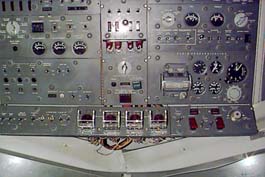
This is the lower portion of the central overhead console.
In the lower middle of the console are four plastic covered red "slam buttons".
These are used to force the connected propellor to feather. This is typically
done if there is some kind of serious engine problem or an engine fire.
For those that don't know, "feathering" a prop adjusts each blade so that
it's parallel to the direction of flight, thus reducing drag.
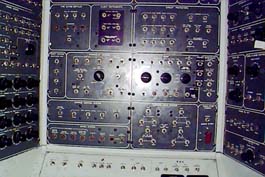
This image is either part of the Instructor Station,
or the Flight Engineering station. I don't recall which.
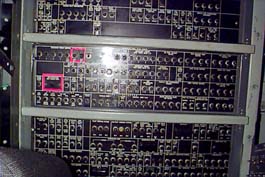
This image is of the Instructor Station. With this
panel, a flight instructor can create various in-flight situations, from
an instrument failure, to an engine fire or runaway propellor.
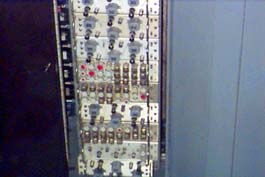
This is a picture of one of the dozens of racks that
contain the hundreds of tubes and relays that make up the computer that
drives the Electra simulator.
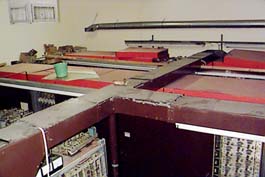
This picture was taken on the deck right behind the simulator
cab. Here you can see the three rows of cabinets that make up the
analog computer for the Electra. There are NO semiconductors anywhere
in this computer. It's entirely tube and relay. Each line of cabinets
is about 35 feet long. and contain dozens of the rotate-out panel assemblies
like that shown in the previous image. Typically, this computer is
turned off when not in use due to the extreme heat it produces and the
incredible thirst for electricity it has. When a crew needs to use
the simulator, they MUST give at least 7 days advance notice. The reason
for this is that it takes 7 days of having the power on for the whole computer
to heat stabilize. Until the computer is "heat-stable" it will not
accurately simulate the Electra because the components haven't had a chance
to "normalize".
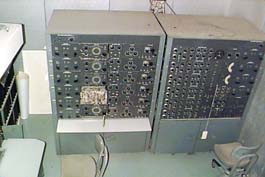
This is the instructor station that's located right behind
the simulator cab. These two cabinets control the radio navigation
beacons like VORs and NDBs, as well as the OMI marker beacon system.
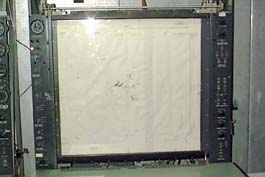
This is the navigation plotting board. This unit
displays where the aircraft is located at with respect to various radio
markers and "terrain". The indicator on the upper left hand side
shows the aircrafts current heading. This is typically used by the
instructor to verify the accuracy of the approaches flown by the students.
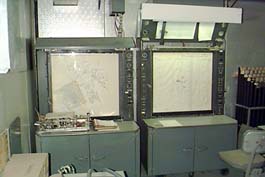
In this picture, you can see the mate to the above station.
The console on the left is what the instructor uses to set up each training
scenario. By utilizing the controls on this console as well as the radio
beacon controls shown in the prior image, he or she can simulate any known
IFR approach in the world.
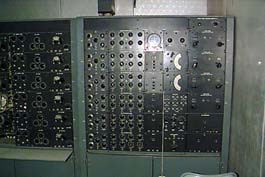
Here is a close-up of one of the radio beacon consoles.
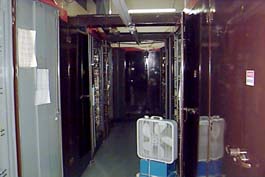
Here is a long shot down the far left row of consoles.
As you can see by the lack of blade-blur in the fan, the computer is not
turned on. :)
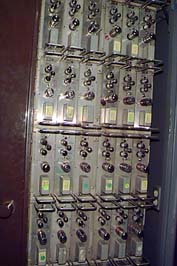
Here is a close-up shot of one of the rotate-out relay/tube
racks. Unfortunately, I don't recall what this particular unit controlled.
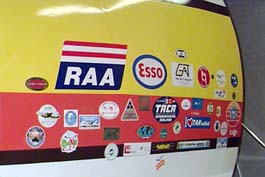
...and here we are back again looking at the side of
the Lockheed Electra. It's become sort of a tradition for each new crew
to use the Electra to bring along a decal that represents the airline or
air service that they fly for. Being the only Electra left, it's
kind of important. Most of the crews that use the Electra these days
come from South America. There are a few remaining cargo carriers
down there that use the Electra for long haul transport. The Electra is
also used (or at least as of 1995) by the Brazilian Air Force. They
use this simulator for navigation and procedures training. On a final note,
the United States Navy still flies the Lockheed Electra. The Navy
calls it the P-3 Orion and it's used for anti-submarine warfare.
In the P-3 configuration it carries many sonobuoys for detecting hostile
submarines and a load of torpedoes for killing them.
I hope you've enjoyed this tour of the Lockheed Electra
IFR and Procedures Trainer.
Gene Buckle
April 24th, 2000.